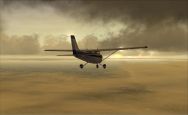| Briefing | May 2017 |
| Overview | For the May Event we will be doing a navigation/accurate flying exercise. |
| Start Time and Place | The event may be flown on any day in May. As it is an individual skills test. There is no specified day for this event as it is best flown alone. Also the route is quite circuitous and even crosses itself, so to have someone else following the same route in close proximity could be off-putting. |
| What Aircraft can I fly | Any aircraft can be flown in this event as long as it is within the EASA GA category. However to "civilianise" this event as far as possible, the use of military or ex-military aircraft types is discouraged. |
| Weather ...or not | Before starting we will check the weather. If it is unsuitable for our trip as planned, then we will fix it. Something we can do in the simulator - wouldn't it be nice if we could do it in real life! For the general handling we need a cloud base that is at least 3000ft AGL. FSInn has a "CAVOK" button. Click this and you get calm clear weather. Those using SB or XSB will need to turn off the on-line weather updates, and select calm in the FS weather options. |
| Flight Planning | Your flight plan should show:
|
| Plan-G | There is no Plan-G file for this Event! It is however advised that you use PlanG to record your track. |
| Event Route Guide | The cruise airspeed is not critical, but must be maintained constant for the duration of the exercise. At a higher airspeed you will cover a greater area, conversely the lower the airspeed the smaller the area that you will traverse! The initial heading of 270 magnetic at the start of the exercise has been chosen to keep the route well clear of controlled airspace. (Bristol's and Birmingham's ATZs.) This is not critical, anything between 225 and 315 magnetic will suffice and keep you outside any controlled airspace, but 270 will make it easy to check your heading at various stages during the exercise! If a cruise greater than 120 knots is chosen, then in order to avoid infringing controlled airspace the initial heading will need to be closer to 270! All turns are Rate 1 - hence the turn times given should allow you to calculate how many degrees you need to turn! (N.b. the distance travelled during the turn is important to achieve the designed pattern / trail for this event, hence accuracy of flying the turns is quite important!) Take off from EGBJ and climb to a cruising height of at least 3000ft agl and trim for the cruise airspeed (120 knots). Maintain this airspeed for the duration of the exercise. Navigate to pass overhead EGBJ on a heading of 270 degrees magnetic. The exercise starts when you are overhead the airfield. (Just before reaching this point turn on the breadcrumb trail in Plan-G!)
Resume your own navigation and land back at EGBJ Check your track in PlanG! |
| Tools / Aids | As the timing of both the level-flight sections and the "Rate - One" turns is quite crucial I have developed an application to help with this accurate timing. It can be obtained HERE. It is voice operated (if desired) to allow "hands-free" operation. To avoid accidental operation by ATC/Teamspeak chatter voice command mode needs to be primed by saying "Voice Mode", and if this gets accidently triggered it can be "de-primed" with the command "Off". All other commands are as per the text on the button for manual operation. |
| ATC | At the time of publishing this event plan, ATC has not been confirmed. |
| Radio Discipline | Take care not to let our Teamspeak chat cut across ATC. Stop any conversation immediately the R/T comes alive, then continue if "he wasn't talking to us". This is difficult because when transmitting on Teamspeak you can't hear the R/T. So be brief on Teamspeak, and be aware that ATC might be trying to get through. If anyone hears an R/T message which seems to be being ignored, just say "ATC is calling G-CIXN" if you have identified the callsign, or "ATC is calling us" which is a cue for everyone to be quiet on Teamspeak until ATC call again (which they will). Remember too that if asked to "Stand By" by ATC, you do not reply - not even "Roger", but simply wait until you are called again. Remember also that there are several different ATC frequencies in use, and you may not be able to hear when communications are taking place. Make sure you have set and know how to use a Teamspeak mute switch. |
| Acknowledgements | Event planning: Max Symons Briefing: Max Symons / Tony Driver. |
